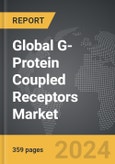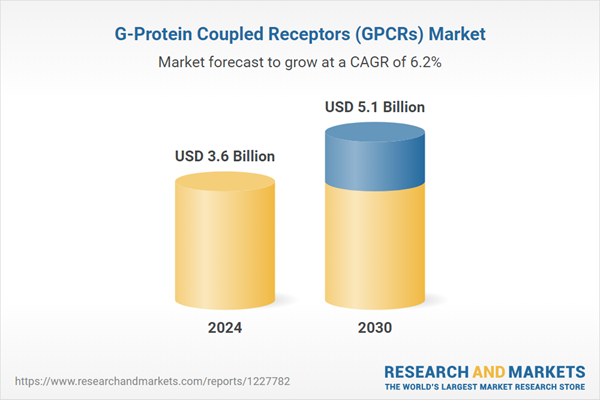The global market for G-Protein Coupled Receptors (GPCRs) was valued at US$3.6 Billion in 2024 and is projected to reach US$5.1 Billion by 2030, growing at a CAGR of 6.2% from 2024 to 2030. This comprehensive report provides an in-depth analysis of market trends, drivers, and forecasts, helping you make informed business decisions. The report includes the most recent global tariff developments and how they impact the G-Protein Coupled Receptors (GPCRs) market.
The significance of GPCRs extends into therapeutic development, as they are prominent targets for a large proportion of modern pharmaceuticals. Approximately 34% of all FDA-approved drugs target GPCRs, underscoring their therapeutic potential. These drugs are used to treat a variety of conditions, including cardiovascular diseases, mental health disorders, and cancers. Advances in structural biology, such as cryo-electron microscopy and X-ray crystallography, have provided detailed insights into GPCR structures, facilitating the design of more selective and effective drugs. Furthermore, novel approaches like allosteric modulation and biased agonism offer opportunities to develop drugs with improved efficacy and fewer side effects by fine-tuning the receptor's response to ligands.
The growth in the GPCR market is driven by several factors. Technological advancements have significantly enhanced our understanding of GPCR structures and functions, leading to more targeted and efficient drug development processes. The increasing prevalence of chronic diseases and the need for more effective treatments drive the demand for new GPCR-targeted therapies. Additionally, the pharmaceutical industry's focus on personalized medicine and the identification of specific GPCRs associated with individual disease states has spurred the development of tailored therapeutic interventions. The expansion of high-throughput screening techniques and computational drug discovery tools has accelerated the identification of potential GPCR modulators. Furthermore, collaborative efforts between academic institutions, biotechnology companies, and pharmaceutical giants have facilitated significant progress in GPCR research and drug development. As the understanding of GPCRs continues to deepen and new technologies emerge, the market for GPCR-targeted therapies is expected to experience robust growth, addressing unmet medical needs and improving patient outcomes across various disease areas.
Segments: Product (Cell Lines, Detection Kits, Cell Culture Reagents, Ligands); Assay Type (cAMP Functional Assays, Calcium Functional Assays, ß-Arrestin Functional Assays, Radioligand Binding & GTPyS Functional Assays, Internalization Assays, Other Assay Types); Application (Cancer Research, Metabolic Research, Inflammation Research, CNS Research, Respiratory Research, Cardiovascular Research, Other Applications).
Geographic Regions/Countries: World; USA; Canada; Japan; China; Europe; France; Germany; Italy; UK; Rest of Europe; Asia-Pacific; Rest of World.
The analysts continuously track trade developments worldwide, drawing insights from leading global economists and over 200 industry and policy institutions, including think tanks, trade organizations, and national economic advisory bodies. This intelligence is integrated into forecasting models to provide timely, data-driven analysis of emerging risks and opportunities.
Global G-Protein Coupled Receptors (GPCRs) Market - Key Trends & Drivers Summarized
G-Protein Coupled Receptors (GPCRs) are a vast and diverse group of membrane proteins that play crucial roles in cellular signal transduction. These receptors are involved in a wide array of physiological processes by responding to various extracellular signals, including hormones, neurotransmitters, and environmental stimulants. Structurally characterized by their seven transmembrane helices, GPCRs activate intracellular signaling pathways through the binding and activation of G-proteins. This activation triggers a cascade of downstream effects that regulate essential functions such as vision, taste, smell, and immune responses. The versatility and ubiquity of GPCRs make them a focal point in the study of cellular communication and pharmacology.The significance of GPCRs extends into therapeutic development, as they are prominent targets for a large proportion of modern pharmaceuticals. Approximately 34% of all FDA-approved drugs target GPCRs, underscoring their therapeutic potential. These drugs are used to treat a variety of conditions, including cardiovascular diseases, mental health disorders, and cancers. Advances in structural biology, such as cryo-electron microscopy and X-ray crystallography, have provided detailed insights into GPCR structures, facilitating the design of more selective and effective drugs. Furthermore, novel approaches like allosteric modulation and biased agonism offer opportunities to develop drugs with improved efficacy and fewer side effects by fine-tuning the receptor's response to ligands.
The growth in the GPCR market is driven by several factors. Technological advancements have significantly enhanced our understanding of GPCR structures and functions, leading to more targeted and efficient drug development processes. The increasing prevalence of chronic diseases and the need for more effective treatments drive the demand for new GPCR-targeted therapies. Additionally, the pharmaceutical industry's focus on personalized medicine and the identification of specific GPCRs associated with individual disease states has spurred the development of tailored therapeutic interventions. The expansion of high-throughput screening techniques and computational drug discovery tools has accelerated the identification of potential GPCR modulators. Furthermore, collaborative efforts between academic institutions, biotechnology companies, and pharmaceutical giants have facilitated significant progress in GPCR research and drug development. As the understanding of GPCRs continues to deepen and new technologies emerge, the market for GPCR-targeted therapies is expected to experience robust growth, addressing unmet medical needs and improving patient outcomes across various disease areas.
Report Scope
The report analyzes the G-Protein Coupled Receptors (GPCRs) market, presented in terms of units. The analysis covers the key segments and geographic regions outlined below.Segments: Product (Cell Lines, Detection Kits, Cell Culture Reagents, Ligands); Assay Type (cAMP Functional Assays, Calcium Functional Assays, ß-Arrestin Functional Assays, Radioligand Binding & GTPyS Functional Assays, Internalization Assays, Other Assay Types); Application (Cancer Research, Metabolic Research, Inflammation Research, CNS Research, Respiratory Research, Cardiovascular Research, Other Applications).
Geographic Regions/Countries: World; USA; Canada; Japan; China; Europe; France; Germany; Italy; UK; Rest of Europe; Asia-Pacific; Rest of World.
Key Insights:
- Market Growth: Understand the significant growth trajectory of the Cell Lines segment, which is expected to reach US$1.9 Billion by 2030 with a CAGR of a 6.1%. The Detection Kits segment is also set to grow at 6.7% CAGR over the analysis period.
- Regional Analysis: Gain insights into the U.S. market, valued at $1.2 Billion in 2024, and China, forecasted to grow at an impressive 8.8% CAGR to reach $416.9 Million by 2030. Discover growth trends in other key regions, including Japan, Canada, Germany, and the Asia-Pacific.
Why You Should Buy This Report:
- Detailed Market Analysis: Access a thorough analysis of the Global G-Protein Coupled Receptors (GPCRs) Market, covering all major geographic regions and market segments.
- Competitive Insights: Get an overview of the competitive landscape, including the market presence of major players across different geographies.
- Future Trends and Drivers: Understand the key trends and drivers shaping the future of the Global G-Protein Coupled Receptors (GPCRs) Market.
- Actionable Insights: Benefit from actionable insights that can help you identify new revenue opportunities and make strategic business decisions.
Key Questions Answered:
- How is the Global G-Protein Coupled Receptors (GPCRs) Market expected to evolve by 2030?
- What are the main drivers and restraints affecting the market?
- Which market segments will grow the most over the forecast period?
- How will market shares for different regions and segments change by 2030?
- Who are the leading players in the market, and what are their prospects?
Report Features:
- Comprehensive Market Data: Independent analysis of annual sales and market forecasts in US$ Million from 2024 to 2030.
- In-Depth Regional Analysis: Detailed insights into key markets, including the U.S., China, Japan, Canada, Europe, Asia-Pacific, Latin America, Middle East, and Africa.
- Company Profiles: Coverage of players such as Merck KGaA, BD Biosciences, Enzo Life Sciences, Inc., Lexicon Pharmaceuticals, Inc., Molecular Devices LLC and more.
- Complimentary Updates: Receive free report updates for one year to keep you informed of the latest market developments.
Some of the 52 companies featured in this G-Protein Coupled Receptors (GPCRs) market report include:
- Merck KGaA
- BD Biosciences
- Enzo Life Sciences, Inc.
- Lexicon Pharmaceuticals, Inc.
- Molecular Devices LLC
- Aragen Life Sciences Pvt. Ltd.
- Axxam SpA
- Abcam PLC
- Eurofins Scientific SE
- HD Biosciences Co., Ltd.
- Addex Therapeutics
- Multispan, Inc.
- Creative Biolabs
- Beacon Discovery
- Distributed Bio
Tariff Impact Analysis: Key Insights for 2025
Global tariff negotiations across 180+ countries are reshaping supply chains, costs, and competitiveness. This report reflects the latest developments as of April 2025 and incorporates forward-looking insights into the market outlook.The analysts continuously track trade developments worldwide, drawing insights from leading global economists and over 200 industry and policy institutions, including think tanks, trade organizations, and national economic advisory bodies. This intelligence is integrated into forecasting models to provide timely, data-driven analysis of emerging risks and opportunities.
What’s Included in This Edition:
- Tariff-adjusted market forecasts by region and segment
- Analysis of cost and supply chain implications by sourcing and trade exposure
- Strategic insights into geographic shifts
Buyers receive a free July 2025 update with:
- Finalized tariff impacts and new trade agreement effects
- Updated projections reflecting global sourcing and cost shifts
- Expanded country-specific coverage across the industry
Table of Contents
I. METHODOLOGYII. EXECUTIVE SUMMARY2. FOCUS ON SELECT PLAYERSIII. MARKET ANALYSISCANADAITALYREST OF EUROPEREST OF WORLDIV. COMPETITION
1. MARKET OVERVIEW
3. MARKET TRENDS & DRIVERS
4. GLOBAL MARKET PERSPECTIVE
UNITED STATES
JAPAN
CHINA
EUROPE
FRANCE
GERMANY
UNITED KINGDOM
ASIA-PACIFIC
Companies Mentioned (Partial List)
A selection of companies mentioned in this report includes, but is not limited to:
- Merck KGaA
- BD Biosciences
- Enzo Life Sciences, Inc.
- Lexicon Pharmaceuticals, Inc.
- Molecular Devices LLC
- Aragen Life Sciences Pvt. Ltd.
- Axxam SpA
- Abcam PLC
- Eurofins Scientific SE
- HD Biosciences Co., Ltd.
- Addex Therapeutics
- Multispan, Inc.
- Creative Biolabs
- Beacon Discovery
- Distributed Bio
Table Information
| Report Attribute | Details |
|---|---|
| No. of Pages | 359 |
| Published | April 2025 |
| Forecast Period | 2024 - 2030 |
| Estimated Market Value ( USD | $ 3.6 Billion |
| Forecasted Market Value ( USD | $ 5.1 Billion |
| Compound Annual Growth Rate | 6.2% |
| Regions Covered | Global |









